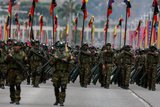NATO Agency Delivers Airborne Chat Capability
Real time collaboration via an airborne internet protocol (IP) based ‘chat’ capability is now possible onboard the E-3 Airborne Warning and Control System (AWACS) aircraft.
For the past 18 months, a highly focused NATO C3 Agency (NC3A) team has been supporting HQ NATO Airborne Early Warning & Control Force Command (NAEW&C FC) to develop, prototype, test and integrate this IP capability onboard the E-3A and E-3D aircraft using low bandwidth carriers.
The aim of the project is to support operational NATO E-3A AWACS missions in deployed locations, specifically where ‘chat’ is the primary mode of command and control (C2) communications and coordination. The ‘chat’ capability can be described as a military form of secure instant messaging between various C2 units and systems.
This capability enables E-3A AWACS crew members to join and communicate with other land or airborne C2, ISTAR units in ISAF and other NATO/coalition operations. To date, testing has demonstrated that the AWACS operators were able to successfully connect and communicate simultaneously in up to six separate ‘chat rooms’ and transfer small files up to 50kb with minimal latency.
“This prototype system offers real promise and will provide NATO’s AWACS battle management asset a credible collaboration facility to support a range of future NATO operations”, said Matt Roper, the Programme Manager.
The NAEW&C FC, “customer”, tasked the development of an onboard IP ‘chat’ system prototype to be employable by E-3A operators that required minimal physical integration into the aircraft and minimal training for maintenance and aircrews. The three primary requirements included the need for an operationally viable capability, a prohibition on integration into current NATO mid-term mission system software and a prohibition on any permanent modification of the airframe.
The prototype was developed as a standalone system, using its own hardware, software and applications. All elements of the system had to be portable and use radio telecommunications capabilities already resident on the aircraft.
As a result, the IP prototype ‘chat’ system employed communications mediums defined as ‘low bandwidth’ – including HF and UHF radios and IRIDIUM SATCOM (using temporary antennas fitted though the E-3A sextant port).
The success of this work is founded on the close working relationships and communication between the NC3A NAEW Scientific and Technical Support Team, HQ NAEW&C FC as the sponsor and the E-3A and E-3D Components.
More from Digital Battlespace
-
![Babcock nears first customer for Nomad AI translation tool]()
Babcock nears first customer for Nomad AI translation tool
Nomad can provide militaries with real-time intelligence, saving critical time on the battlefield.
-
![AUSA 2025: Israel’s Asio Technologies to supply hundreds of improved Taurus tactical systems]()
AUSA 2025: Israel’s Asio Technologies to supply hundreds of improved Taurus tactical systems
Taurus operates alongside the Israel Defense Forces’ Orion system which supports mission management across tens of thousands of manoeuvring forces, from squad leaders to battalion commanders.
-
![AUSA 2025: Kopin pushes micro-LED plans as China moves faster]()
AUSA 2025: Kopin pushes micro-LED plans as China moves faster
The plan for the new displays follows fresh investment in Kopin’s European facilities by Theon and an order for head-up displays in fielded aircraft, with funding from the US Department of Defense.
-
![AUSA 2025: Persistent Systems to complete its largest order by year’s end]()
AUSA 2025: Persistent Systems to complete its largest order by year’s end
Persistent Systems received its largest ever single order for its MPU5 devices and other systems earlier this month and has already delivered the 50 units to the US Army’s 4th Infantry Division.
-
![Aselsan brings in dozens of companies and systems under the Steel Dome umbrella]()
Aselsan brings in dozens of companies and systems under the Steel Dome umbrella
Turkey has joined the family of countries attempting to establish a multilayered air defence system with government approval in August 2024 for the effort landed by Aselsan. Dubbed Steel Dome, the programme joins Israel’s Iron Dome, the US Golden Dome, India’s Mission Sudarshan Chakra and South Korea’s low-altitude missile defence system.
-
![DSEI 2025: MARSS unveils new agnostic multidomain C4 system]()
DSEI 2025: MARSS unveils new agnostic multidomain C4 system
MARSS’ NiDAR system has been deployed using sensors from static platforms to provide detection and protection for static sights, such as critical infrastructure, ports and military bases.


























